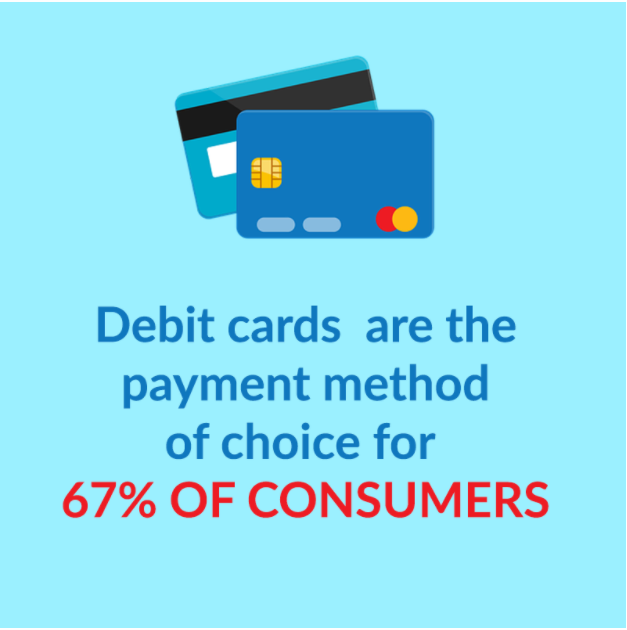Debit cards are the payment method of choice for 67% of consumers.
In a world where so many consumers are gun-shy about spending money they don’t have, the popularity of debit cards should come as no surprise. Most financial institutions even have apps that let consumers deposit checks remotely and track their debit card spending as they go.
But all debit card processing companies aren’t created equally.
Let’s take a look at the ins and outs of debit card processing and the fees that are involved, so you can learn how to maximize revenue on every transaction.

How does debit card processing work?
When a customer swipes their card or inserts a chip, your point of sale system registers their card info and sends it to their issuing bank for verification. Their bank then confirms that they have money in their account for the purchase, performs a security check, and (hopefully) approves the transaction.
There are two types of debit card transactions you’ll encounter in your business: PIN and signature.
PIN debit transactions are the most popular form of debit card processing services. Debit card networks usually have low percentage fees and high interest rates, so PIN transactions are best for larger purchases with smaller banks.
Transactions are categorized as “PIN” when a cardholder chooses “debit” at checkout, and they require customers to enter a 4-digit PIN number for identity verification. PIN transactions are also called online debit card payment processing, since they use online debit banking networks to process each customer’s card info.
Signature debit transactions use credit card networks to process transactions. Since credit card networks generally have high percentage fees and low interest rates, signature transactions are better for smaller purchases with larger banks.
These transactions happen when a customer chooses “credit” after swiping their debit card, and they require customers to sign a receipt instead of typing in their PIN. Signature transactions are also called offline payments.
Technically, there is a third type of debit card processing:
Keyed in transactions. Keyed in transactions are much more expensive to process, but they only happen in cases where your customer can’t swipe their card or your system is offline for some reason. To minimize keyed in transactions, integrate your POS system with your payment processor or use a modern POS/card reader that can read cards other machines can’t.
How is debit card processing different from credit card processing?
Debit and credit card processing are two totally different processes. They’re even totally different when your customers choose the “credit” option when processing their debit card at checkout.
Credit card processing is more expensive, and it has more moving parts. To process a credit card transaction, your POS system sends information to a payment processor––like Payment Depot––before sending the info to your customer’s card-issuing bank. And once a credit card payment is approved, it goes through your customer’s payment processing company one more time before the transaction reaches your system.
Only payments made with credit cards come with surcharge fees, which makes sense because the payment processor does a lot more work to process those transactions.
Debit card processing fees, on the other hand, are lower, so you can afford to accept debit cards for smaller transactions. But with debit cards, consumer spending is limited to the money already in their bank account, which means there will always be customers who shop with credit cards out of necessity.
When your customer makes a debit card transaction, their 16-digit card number and accompanying data are routed to their card-processing network (Visa, MasterCard, etc.) and then to their card-issuing bank to ensure that they have the necessary fund in the customer’s account to make the purchase.
How much are the average debit card processing fees?
Debit card processing costs depend on a few factors: whether the card is regulated or unregulated, the size of the transaction, what type of business you have, and whether it is a signature or a PIN transaction.
Because there are so many variables, it’s hard to pinpoint the exact debit card fees that you’ll pay as a small business. To give you some ballpark figures thought, the card issuer Visa states the following in its latest fee documents:
- Debit card fees for small ticket transactions – 1.55% + $0.041 (Exempt Visa Check Card Card Present Transactions)
- Debit card fees for small ticket transactions – 0.05% + $0.21 (Regulated Visa Check Card Card Present Transactions)
- Debit card fees for retail – 0.80% + $0.15 (Exempt Visa Check Card Card Present Transactions)
- Debit card fees for retail – 0.05% + $0.21 (Regulated Visa Check Card Card Present Transactions)
Do note that the above debit card processing rates are just your interchange fees, and the fee that you’ll ultimately pay may be subject to markups from your payment processing solutions provider.
More info below.
Debit card processing fees are called “interchange rates.” Your account provider will also charge you a “provider markup” on top of your interchange rate, but how much you pay for that provider markup will vary depending on your merchant service provider’s pricing structure.
There are both tiered and interchange-plus pricing structures. Like with credit card processing, tiered pricing plans charge varying amounts for different transactions, while interchange-plus uses a fixed markup over interchange for each purchase––so you can create a workable budget for card debit processing based on the transactions you typically process each month.
What technology (hardware and software) do merchants need to process debit cards?
To process debit card transactions, you’ll first need a debit card processing machine. The good news is that you can process debit cards with the same POS system, smart terminal, or standard terminal that you use to process credit card transactions.
Keep in mind that credit card processing and debit card processing take place on entirely different networks Debit card processing online requires a strong, accessible WIFI connection.
You’ll want to keep your in-house WIFI network separate than the one that your customers can access for security purposes. You may also want to enable offline debit card processing if your store is located in an area where internet connection is unreliable.
Understand the different payment options
Processing credit and debit card transactions gets really complicated, really fast. But if you take away two key points from this article, let them be these:
- You will want to be sure that you’re working with a payment processor that offers interchange-plus pricing on debit card transactions, so you can get the lowest rate every time your customers make a purchase.
- The reality is that payment processing is a complicated industry and, if you’re paying attention to your statement, questions are going to arise. Align yourself with a payment processor that offers 24/7 in-house customer service, so you always have the resources you need to make an informed decision.




